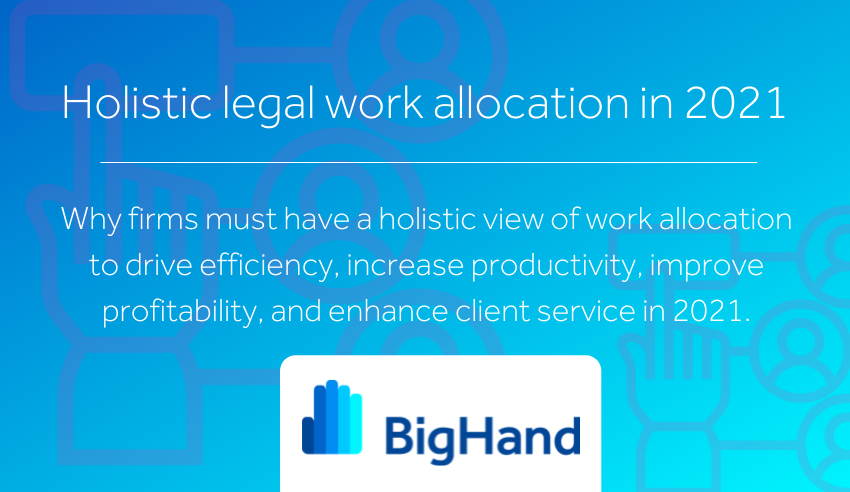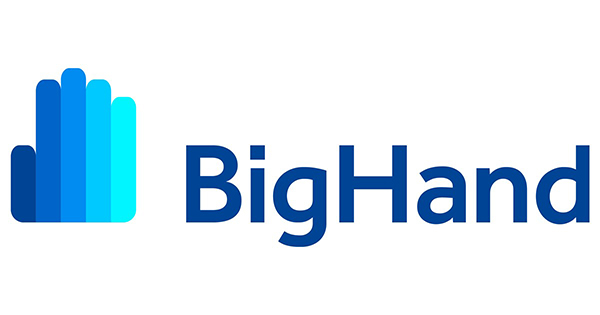Holistic legal work allocation in 2021
Why firms must have a holistic view of work allocation to drive efficiency, increase productivity, improve profitability, and enhance client service in 2021.

People are the most important asset to the legal industry. It’s undeniable to any law firm of any size or practice type. So it’s no surprise that assessing how work is allocated, managed and completed is an ongoing priority for law firm leadership.
But recent events have taught us that a holistic view is key. Firms need to take a step back, and look at legal work allocation from partners, to associates, to support staff to understand the bigger picture. That’s not to say there aren’t short-term gains to be had – but they must be made as part of a bigger view.
Get it right, and not only can you drive efficiency gains, increase productivity, improve profitability, and enhance client service – but you can have a hugely positive impact on staff retention. By improving lawyer career development and overall engagement you can also make an impact on the firm’s goals around Diversity, Equity and Inclusion (DEI).
2020 saw two catalysts spark demand for better legal work management in law firms globally. The pandemic, which introduced remote working on a scale never seen before and has made everyone think about how to successfully encourage a ‘work from anywhere’ standard in 2021. And the BLM movement, which put pressure on firms to look closely at their DEI policies to ensure they’re meeting client demands for diverse staffing of matters.
‘Work-from-Anywhere’
As we transition to hybrid-working, firms should take the opportunity to change the problematic tradition of lawyers simply walking over to an associate with a task for them to complete. Delegating legal work based solely on personal preference, relationship or proximity to that resource, is not effective. Not only can this cause bottlenecks of work, but it does nothing to help associates gain access to career enhancing opportunities.
In the back-office, economic pressures and the physical distance between lawyers and support staff has accelerated pre-existing plans to restructure support teams, and/or modernize traditional roles. Many firms are looking to retrain, upskill and redeploy staff, save on real-estate costs, and ensure the right technology is in place to allow for full legal workflow visibility as well as surfacing the associated data to make informed, fact-based staffing decisions.
There are several benefits to a project of this kind. There is the obvious impact to profits, not just through office consolidation, but also ensuring the right work is completed at the right cost to the business. The efficiency and productivity gains are key too, with more even distribution of work to avoid burn-out or underutilization across teams, and the resulting optimization of turnaround times and improvements in client service.
Beyond that, there’s the standardisation element which is sometimes overlooked, but of great importance when looking to future-proof a firm against long-tenured support staff approaching retirement. Without succession planning in place there is the risk of loss of institutional knowledge that is so critical to maintaining clients. All too often, senior legal secretaries will have ‘their own way’ of doing things based solely on anecdotal experience of ‘how my Partner likes it’, which creates significant challenges due to absences, reassignment or turnover.
Equity, Diversity and Inclusion
If we flip from support staff to time-keeping staff, the BLM movement has turbocharged legal DEI initiatives in a very positive way. DEI has switched from being a HR initiative to a commercial necessity for firms in 2021. To say nothing of the fact that it is simply the right thing to do.
Firms must actively address how work is allocated to lawyers in a fair and unbiased way to meet client needs and promote engagement and career development internally. Add the complexities of remote working into the mix – and now could not be a better time for firms to start a legal resource management project to stay ahead of the curve.
Dave Cook, Commercial Product Director for Resource Management at BigHand notes, “More and more firms have been looking at legal resource management as a way of driving efficiency and productivity but importantly, also focusing on this approach to increase lawyer engagement and address issues with DEI. The BLM movement raised the priority level of EDI to the very top of the agenda for firms. Both strategic and practical steps to address this have become essential for firms from a client, people and moral standpoint.
Lawyers and law firm professionals, regardless of background, are watching closely and want to see their firms react with positive and substantive interventions to address these issues. There is complete solidarity around this. If firms choose to do nothing, their people will move to firms that have put committed steps in place.
Legal resource management is not an DEI intervention per-se but the dramatic, positive impact it has in this area makes it a key pillar for all firms in addressing DEI challenges, all the while increasing overall productivity, client delivery and profitability. It is, and will continue to be, a critical operational process that law firms need to introduce to remain competitive.”
Data and Technology
With any change management project, accessing reliable data on the current status quo should be the first step – you can’t manage what you can’t see or understand. Then you need a champion to really drive change. Someone who is passionate about the outcome to really put the work in upfront. Then there’s the technology to underpin process change, provide visibility of who is working on what, where opportunities have been missed and provide data on where to make continuous improvements.
The good news is that 2020 removed many barriers to legal technology adoption and traditional ways of working have changed for good. Law firms would be remiss not to exploit that change in attitude to make both short and long-term technology advances in 2021 to future-proof their business.
Ultimately, support staff and fee-earning staff initiatives must be looked at as equally important to protect and nurture the people in a firm. To make systemic change you cannot address one without the other, and both should be considered holistically.
To find out more about BigHand’s solutions, visit the website here: https://www2.bighand.com/en-au/our-solutions/
